More than half of the entire Namibian population lives in Ovamboland, on just 6% of the territory. The Ovambo are by far the country’s largest ethnic group, and the term Ovamboland (a homeland, territory reserved for Black people under the apartheid policy) is still in use in spite of the post-1990 administrative division. In order to reach Tsumeb from Opuwo (Kaokoland), I have to cross this entire region from west to east.
It will take me approximately 6 days for 600 km, since the road is tarred and straightforward. I will be cycling on the north side of the Etosha National Park, this huge game reserve that can’t be cycled (like all the brown areas here, accessible only with a permit or if you belong to De Beers).

As I walk out of my tent, enjoying the first steps under the rising sun of the beautiful day ahead, I have that feeling that I am watched. Something moved in the rocks. Oh, and now a small head popped out and hid again. After more careful observation, I realize there are a dozen of marmots watching me. Not kids this time, just marmots.
Once on the road, I realize soon that the Namibian cycling paradise, that I was so much looking forward to, won’t be as smooth and as interesting that I had imagined. It’s very hot, it’s not easy to find water, and the wind is against me. I kept with me the 5 L jerrycan so I carry now 10 liters of water. That’s 10 extra kilos! My road for the next six days is pretty straightforward: east. I was told a wind from the east means no rain, it’s good, but these long straight segments without anything but headwind can be depressing.
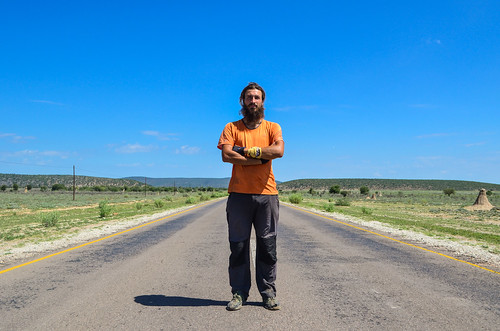

Nice road, nice tar, little traffic. Many pick-up Toyotas commute between the various towns of the region, and the passengers are standing up in the cargo area. At 100 km/h, it looks very easy for something bad to happen to them. On the other hand, helmets are mandatory for cyclists!

The journey quickly gets boring. There is nothing much to watch or do. At the junction between C41 and C35, at a small settlement looking like in the Far West, I can buy meat and chips, much better than fufu and fish! Food until now was healthy (maybe … I’m still unsure about eating cassava every day being healthier than meat and potatoes), and now it’s gonna be fat and tasty! However, everyone claims there’s no water here (then what are you all drinking?) until a lady takes me to her house to fill up my 5 L tank, that I had finished in just one morning. The water is not that clean, it must be coming from a well nearby. From now on, it’s getting even more boring. You can see on the bikemap above, that 100-km long straight line to Okahao is my road, without any single turn. Like in the Sahara, my butt hurts. It happens when the road is so straight and flat that my position on the saddle never changes.
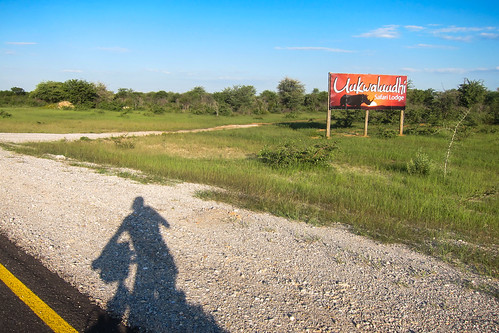
I stop to set up my tent when I see a tank and tap near a farm, so I can shower with cow water. This part of the land is empty of houses, but there is cattle everywhere. It looks like an extensive natural T-bone steak factory, but at a too early development stage for my stomach.
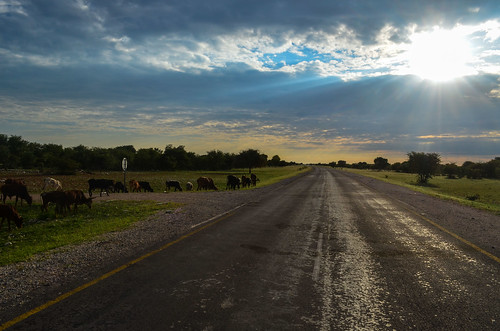
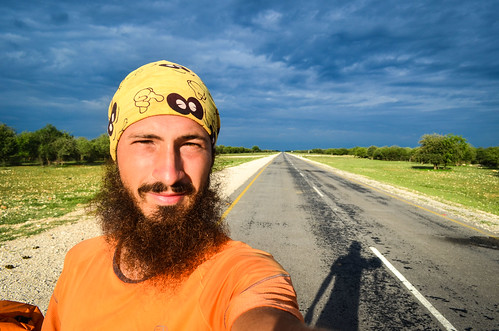
It’s still very hot and very boring: 66 straight kilometres until the next town, Okahao.
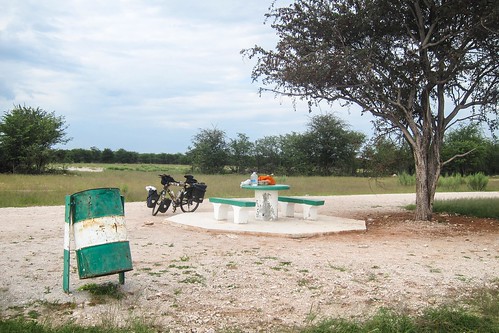

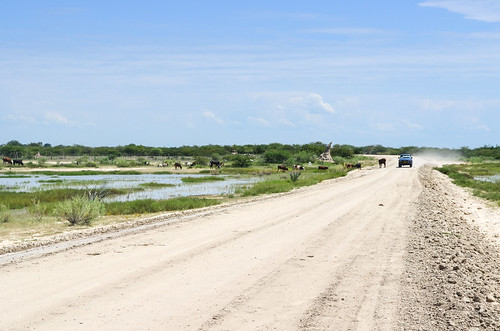

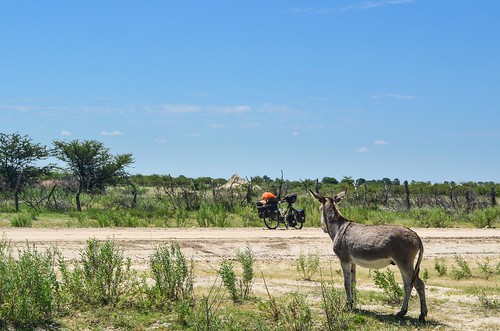
Okahao is the largest town in the area with a mere 2000 inhabitants. As I’m still new in Namibia, I keep comparing it to where I come from: this town has more large businesses than a city of 100’000 in Congo, Cameroon, Benin, Côte d’Ivoire, Gabon … Ah no, Gabon has only two cities over 100’000 and I’ve not been there. Two supermarkets (Shoprite and Woermann), a plethora of fancy Chinese shops, construction material warehouses, banks and ATMs, … it looks quite impressive to me. The downside is that all the shops are indoor. There are no ladies selling basic stuff, vegetables and food by the road side. The absence of street sellers, the white sand on the sidewalks, and the fact that most of the people travel in old rusty Toyota pickups instead of walking, make it feel like a different continent from Angola and above.

There’s many bars and shebeens, and the old keep drinking through the day. It doesn’t look like fun life. Boys wear winter hats and ladies walk with umbrellas to protect their skin from the sun. The proximity of South Africa is great, it’s plenty of good food from there. I can buy a real mango juice for 80 cents a liter, instead of the 4 USD ones imported from Turkey or the UAE sold in the expats supermarkets of Cotonou or Pointe-Noire. I can splurge on good products, compared to “before”, when I would find a rare supermarket and buy only one or two items to remind me how cheese and chocolate taste like.
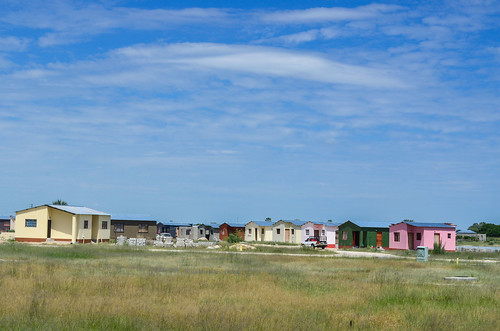
I am surprised at the many Chinese shops in town. There’s already a very good offer for consumers, but the Chinese are invading also Namibia! Most of their shops are called “China shop” and filled with anything that can be made out of plastic and aluminium. It’s time to look for new shoes. But here too, the biggest size is always 44 … There’s even fake Salomon trail shoes! These are very good ones (and sold for 1/10th of their usual price), it’s a pity there’s not my size. At my last shop visit, there is one pair of 45, maybe the only 45 of the whole town. Nike low hiking shoes for 10 €, slightly too tight, but they will do the trick. Anything will be better than walking half barefoot and getting stones and thorns into my feet.

And it feels so good! New shoes after a long time with broken shoes. It’s like finding a roadside stall on the road after many hours thinking about food. All my pleasures are very simple ones: food after starvation, water after dry lips, much needed equipment after a long time of discomfort, etc. And these pleasures are truly more intense than those considered as rarely accessible. It reminds me of some texts of Seneca studied in Latin classes at school.
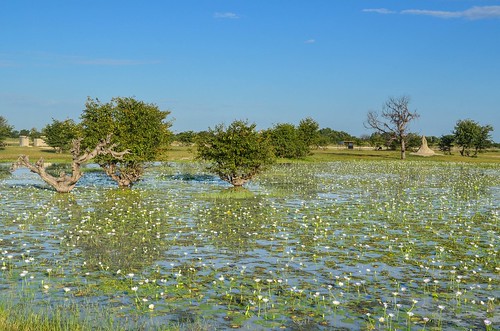
I’m still enjoying my new good life and I end up again buying too much food, I can’t carry it. If I try to eat and drink enough of my purchases so that the rest fit in my panniers, then my belly is too full and I can’t cycle anymore. Ah, what a dilemma …

This blicks maker is found next to a botore store. I’m not in Japan, but it’s full of engrish!
The reason why the land is so wet all around me, while it was super dry 100 km ago, is because I pass near the Etosha pan just after the rainy season. All these swamps are filled with water coming from Angola and the Kunene river, and going towards the Etosha pan without reaching it.
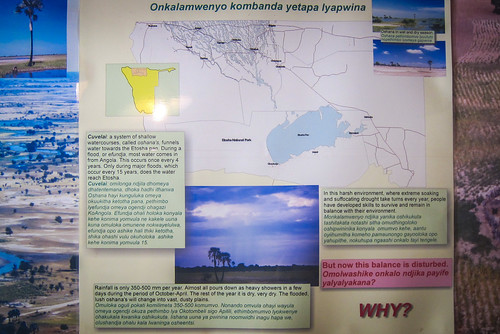
It even looks tropical with the palm trees. The fact is that I am still between the tropics (23’26°N -23’26°S), but just like most of Mauritania and Mali, which rarely fit with the image of tropical countries. I’ve seen pictures of this area when it’s dry, and it looks much more like southern Mauritania. There is plenty of small hamlets by the road, comprised of simple brick houses, half of which are bars.
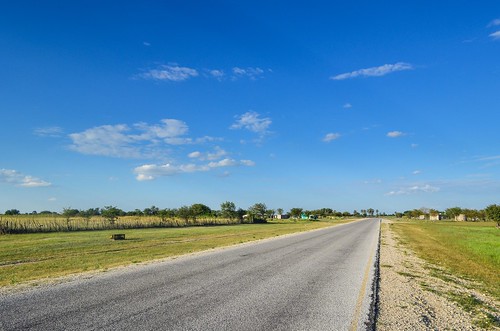
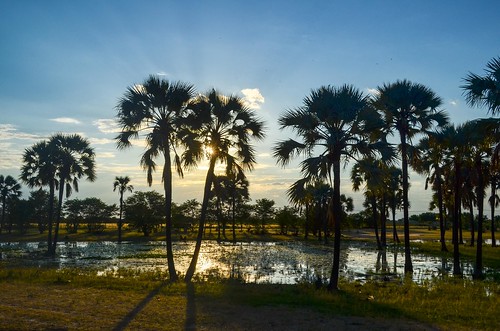
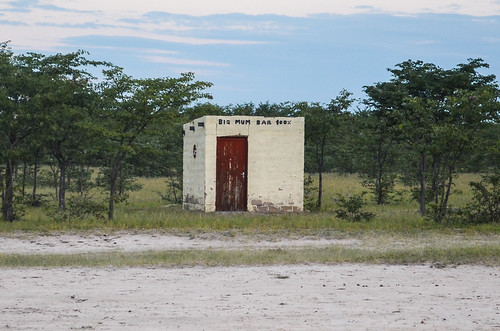
The last forty kilometers to Oshakati, one of the largest cities of the country with a population of 40’000, are flat and fast. I arrive straight into the commercial area: Game, Mr. Price, Clicks, Ackermans, … all major South African retailers are here. The greetings also remind me of South Africa. One must systematically ask “how are you?” to the shopkeeper, cashier or customer, which will be answered with “I’m fine and you?” and then “fine thanks“. It’s so mechanical that I could answer “cassoulet” to the first question, the other would still say “fine thanks“.
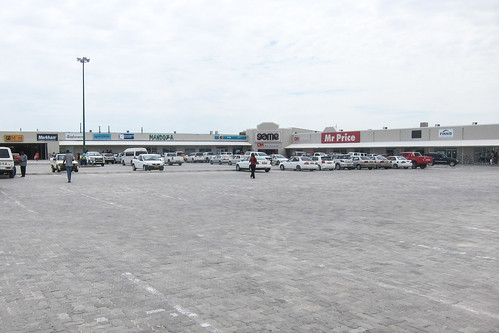
Yes, that’s definitely the end of the wild adventure, I’m on a shopping mall parking. Leaving my bike with all my stuff in front of a large mall while going into the maze of shops makes me uncomfortable. There are just the useless guards, difficult to trust. Yet, I can’t leave this place without a new air mattress. I get a cheap one for 18 USD, almost the same I got in Angola for 50 USD, so I can get rid of it and its four patches. Next stop: food. There is a Wimpy burger at the Engen gas station, great! I’m going to enjoy a rare fat burger. But it’s quite expensive and not as good as in my memories. Watching through the window, it could be like South Africa. Some prices are even labeled in rands (there is a one-to-one parity between the rand and the N$). I hadn’t seen many White people so far, but here they come. Big shaved head, big belly, a check shirt tuck in short shorts, and high socks in boots. A peculiar definition of sexy. On the other hand, some Black security guards, sitting in the shade all day long and getting paid for it, ask me for 5 dollars because they are hungry. Excuse me, I am the one who cycled 230 km since Opuwo with little food on the way and I’m really hungry.

All the buildings and shops have one story only. Everyone moves by car. There is no charm in this place. Everyone is dressed like anywhere else with western clothes. I don’t feel good in the urban jungle. I used to leave my bike anywhere to go shopping or to take a walk around, but here there’s too many people and I need to adapt to the development. It’s like the impersonal Europe where you wouldn’t leave your bike unattached in a town. As a matter of fact, I have never used my heavy padlock since I entered in Africa, it has been a useless mass tied to my seat post. In the beginning, I was locking it at shops or at night when wild camping. But it quickly appeared unnecessary: people wouldn’t steal it. And I’m almost sure that no one can steer a fully loaded touring bike and pedal far without practice. I’m always surprised at how heavy and hard it is after 10 days of rest off the road.
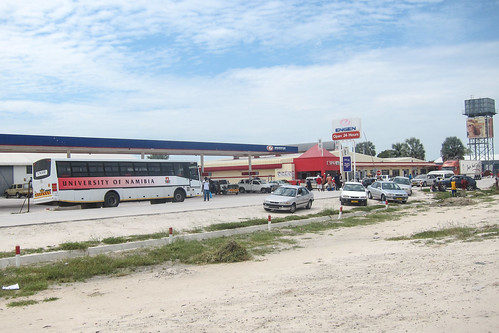
The traffic has been very quiet until here, and it’s a hell to cycle in Oshakati. The two lanes per direction are just wide enough for two vehicles and they don’t hesitate to race on it, passing super close to me. Ondangwa is another large town just 30 km after Oshakati, and I have to cycle the road in between as fast and as safely as possible.
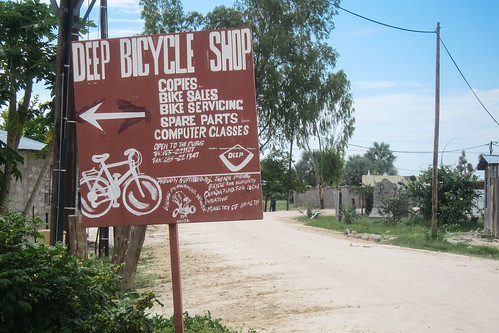
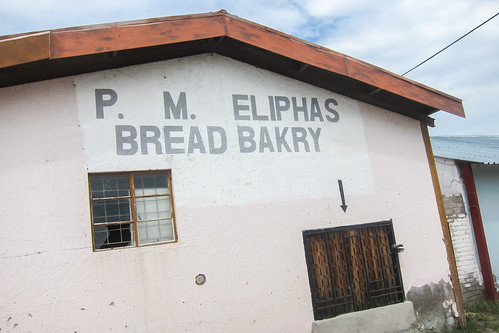

Instead of bush camping, I fall for the campsite of the Nakambale museum, with electricity, hot shower and a kitchen. A little comfort feels good.
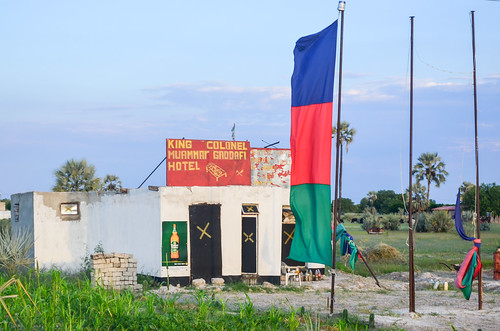

The Nakambale campsite was inaugurated by former president’s wife. Just like the Shoprite supermarket of Oshakati was opened in 1996 by Sam Nujoma, the first president of Namibia, in office from 1990 to 2005. By the way, 100% of the (two) Namibian presidents have a cool beard. In a country with a population of 2.1 million, I guess it’s easy to have the president at every venue.
The Nakambale museum honors the Finnish missionary Martti Rautanen, one of the first in Namibia. As a result, the museum is filled with Finish and Ovambo items. Martti Rautanen lived in Olukonda village from 1870 until his death in 1926, learnt Ndonga and translated the bible.
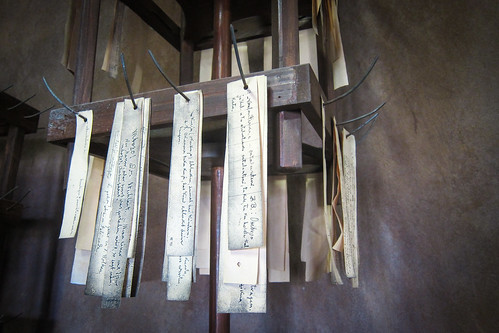
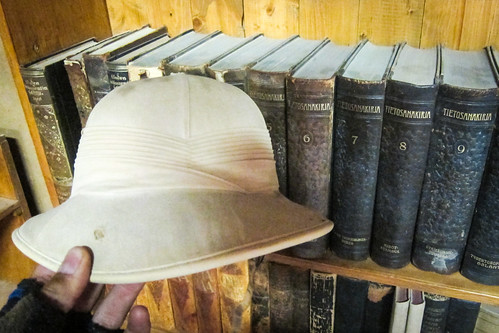

From Ondangwa until Tsumeb, that’s about 275 kilometers of boring road. The map above doesn’t need words: not a single turn and perfectly flat.
Cars still honk at me like if I don’t belong to the road, and overtake dangerously. I was expecting better manners from Namibians. What really surprises me is the presence of many shops and food joints by the road. Despite the low population density, it’s easy to get a russian & chips and a Coke every 10 or 20 km. There’s even small supermarkets in small settlements.
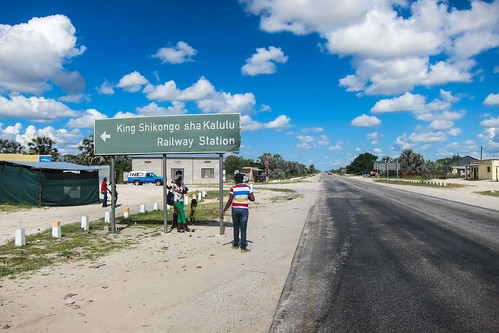
Electricity makes it possible to get a cold coke and warm fries out of the towns, it’s fantastic. As an element of comparison, 98.9% of all Brazilian households have access to electricity, 99% of all Chinese people, and 11 of the 28 Indian states have a rural electrification rate over 80%. Wikipedia states that, on the other hand, less than 10% of the rural population in Sub-Saharan Africa has access to electricity in 2012.
As a consequence of development, for me, as a visitor, I feel there is no more charm and seemingly no culture, as compared to my previously traveled places. Everybody is dressed western, buildings are uninteresting heaps of bricks, food is fast food (microwaved fries with frozen sausages or fish). No or little personality. No ladies carrying things on their head, no food outside, much concrete and tar, and omnipresence of beer.
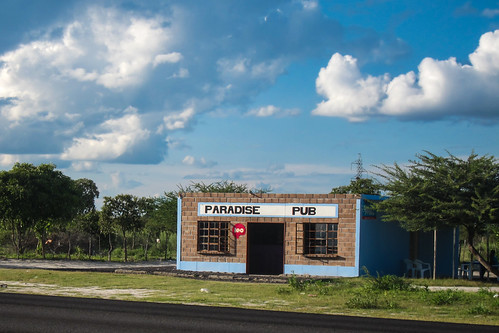
I don’t know how to explain it, it just doesn’t fit with the Africa I have experienced until now, and it feels strange. I didn’t have this feeling in Accra or in Dakar. Maybe it’s too quiet here? Too clean? Perhaps it’s the fact that rural places have the good infrastructure of a city, and there’s no “village feel” anymore?
Perhaps it’s because it’s no more adventurous? ATMs are everywhere, small shops accept credit cards, there is no surprise about which food to expect in the next town. Things are so predictable. The network is good, I get signal everywhere. Internet is fast, even in 2G it’s better than the 3G of some other places. I should be happy to be back in the first world, but the awe inspired by the good infrastructure is quickly taken over by boredom …
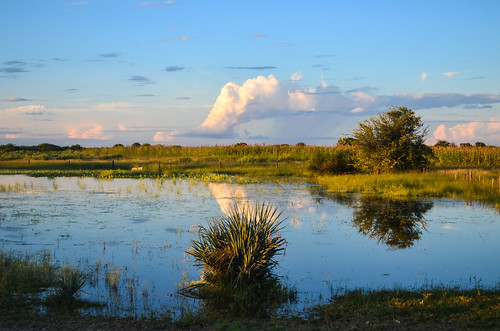
I can rate the interestingness of my my days with the number of pictures I take. Around 80 for an average day, over 120 for a scenic day, and around 25 for a boring day. These days are more like 20. The straight and boring road makes me stop every 20 kilometers (i.e. every hour) to rest my butt and to drink a 1 L ice cold bottle of coca-cola.
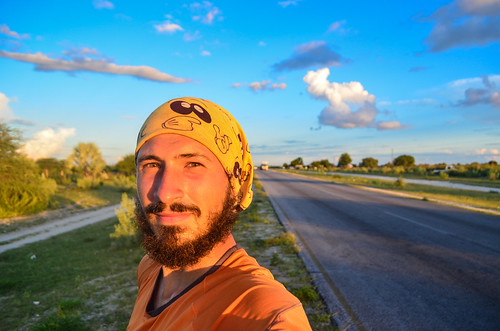
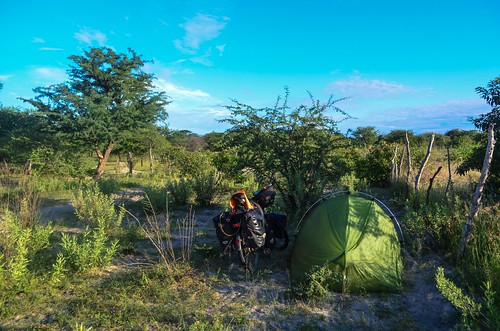
The land is flat and suitable for camping almost anywhere, but finding a camping spot is tricky. I can’t just wait for sunset and hide a hundred meters from the road. Despite the scarce population, everything is fenced. There are fences along every road. If it continues like this (and I was told it does), it will be preferable to ask at a farm the permission to enter.
In shebeens, people drink mahangu, a beer made from millet. It is kind of the equivalent of the palm wine. On the other hand, the palm trees of Namibia, the makalani, are used to make strong liquor. One can also use the marula fruit to make beer, but it’s not as tasty as amarula.
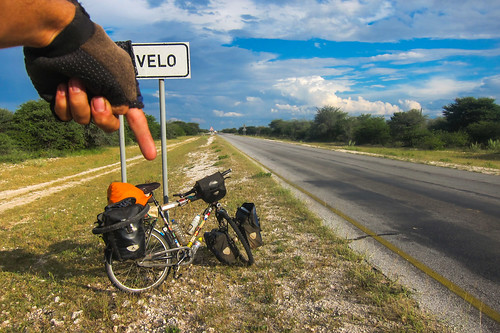
Almost all towns start with the letter O: I passed Opuwo, Okahao, Oshakati, Ongwediwa, Ondangwa, Omuthiya, and am now in Oshivelo.
Despite all the home-made alcohols available, I stick to the liter of cold coca-cola for my cycling breaks. The flat and straight road going fast, I can complete my daily 100 km in 5 hours of efforts, allowing me to make a lot of breaks. And to rest my butt.
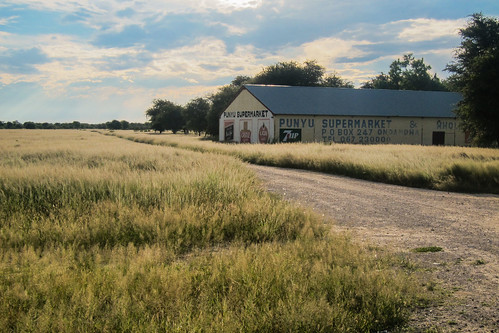
In a shebeen, a local business man tells me that “people are poor and the government is rich! We are only 2 million Namibians. If they give just 1000 dollars monthly to everyone, it will work out“.
I guess he means 1000 N$, so 100 USD. It may be possible, just like in all these resource-rich countries, where the GBP per capita is ten times more than the average annual salary (if any). The concept of “the government must provide” is must better understood than the concept of earning money. Several times, I felt like disturbing the lady sleeping on the counter when I asked for a Coke.
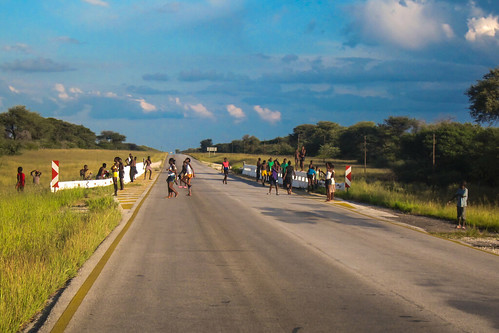
On these long roads, I hear my chain cracking, despite careful cleaning and lubing, like when my previous one died … It’s not normal I have to replace it this early! Well, this time I will be able to buy a good new one at Namibian sport shops.
Very little happens, except a white Toyota driving too fast and honking while overtaking me too close. The car reads “Police”. Anyway, I can’t do anything against this …
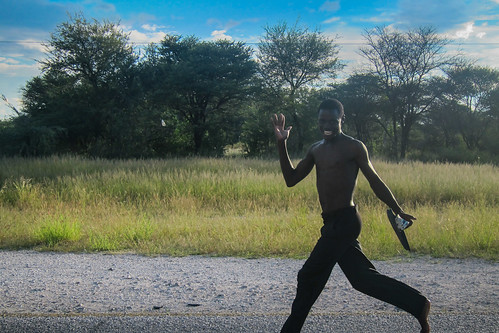
Since I passed Oshivelo, there is absolutely nothing on the road, not a single house. In Ovamboland, there were bars every 5 or 10 km until now. How come it’s so empty now? I camp near the turn-off to the Etosha National Park, without having seen any wild animal. Only cows.


I realized later what happened. When I left the village of Oshivelo, there was a checkpoint, a “vet checkpoint”.
It actually signaled the exit of the VCF, the Veterinary Cordon Fence, also called the Red Line of Namibia. It is a physical fence to, originally, separate the Blacks from the Whites. Apartheid was practiced not only in South Africa, but also in Namibia. Though I was told it was not “that bad” here, where “bad” could mean Blacks can’t leave the boundaries of their homelands without papers in order, and probably worse things …
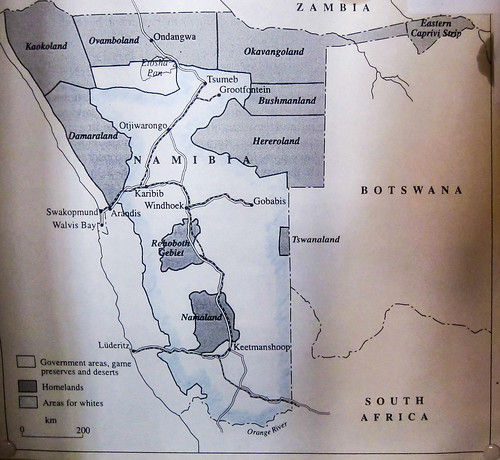
This map explains why, still today, the small Ovamboland gathers half of the Namibian population. The population density there is 10 /km2, five times more than the country average.
The Red Line evolved into the VCF, to avoid movements of cattle between the “north” and the “south”, preventing the diseases from the north to contaminate the south. It is true that on the northern side, the cattle is roaming freely everywhere, whereas in the south, the White farmers keep the livestock within fences. I have seen cows and goats eating trash, paper, cardboard, plastic bags and even chewing on PET bottles. Well, I have seen that in India too. The meat produced in the north is not allowed for sale anywhere but in the north, while the meat produced in the south can be sold anywhere and exported.
What surprises me is that, 24 years after the abolition of homelands, the fence is still in effect and the meat from the north can’t be sold elsewhere. And that there is not a single house, a single shebeen, on 80 km between Oshivelo the Otjikoto lake.
Since I left my camping site, I have not seen a single house for 60 kilometers. Only fences and the railway. The rain hits me and I have nowhere to shelter.
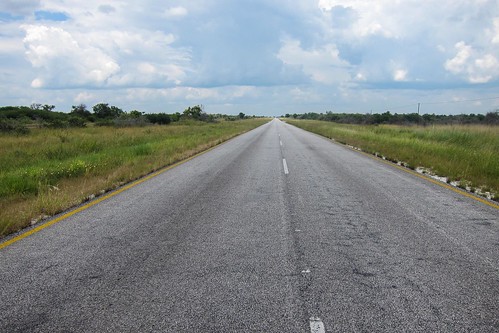
The rain is getting heavier, falling almost horizontally pushed by a strong wind, and the only thing I found is a tree. The fog invaded the land and the wind is strong enough to make my bicycle fall off its kickstand. Unable to see anything and to drive, some cars stop. Within a few minutes I am completely drenched, from head to toes.

I can’t do anything but hope that it doesn’t last for too long. It’s cold. I should reach Tsumeb tonight, it’s 40 km away, and definitely need to find a dry place. I get on the bike after the rain passes. The wind will dry my shirt off, but my shoes are still a foot bath. Twenty kilometers before Tsumeb, I stop at the Otjikoto lake, a sinkhole lake with lots of history.
Namibia was first colonized by the Germans. It started in 1882 when the German trader Lüderitz started to buy land on the coast, the little African land remaining unoccupied by other European superpowers. By 1884, he involved Bismarck who would declare present-day Namibia as German South-West Africa. During the World War I, Germany lost its colonies (incl. Togo, Tanzania, Cameroon) to the French and the British. For the case of South-West Africa, the then Prime Minister Louis Botha informed the British that South Africa was strong enough to defeat the Germans. They were allowed to, and they did (and then occupied Namibia until 1990 against UN decisions). During the defeat, the German soldiers dropped their weapons into the Otjikoto lake.

No one knows how deep the lake is. Divers never reached the bottom, but estimate the depth at more than 145 m (for a diameter of 100 meters)(map). However, they managed to raise to surface in 1983 some German artillery that was laying there since June 1915. The retrieved cannons can be seen at the Tsumeb museum, and they look in a very good shape.


It is also said there is a mysterious safe with gold laying at the bottom …
By the time I want to hop on the bicycle again to reach Tsumeb, the rain comes back. The people at the small office of the lake offer that I camp in the storage room, and I also find it’s better than arriving drenched in a city at night.
These people are Damara and they speak Khoekhoe, a language with clicks. I ask them to teach me how to count, but I quickly quit. The words for one, two, three, each contains a different click. I can’t explain how ridiculous it sounds if I try, so here is a video for self-teaching. The winners can go to dance.
Whenever I talk about Angola, where Namibians are theoretically allowed to enter visa-free, the Namibians always reply that they never go there. “The police is too mean and it’s too risky to visit“. I’ve never been seriously asked for bribes there, but I wouldn’t be surprised if they abuse their neighbors. However, the Kwanyama people of southern Angola, in the Cunene province, are the same as the Ovambo people of Namibia.
The lake has also the remains of an old steam engine that used to pump the water out.
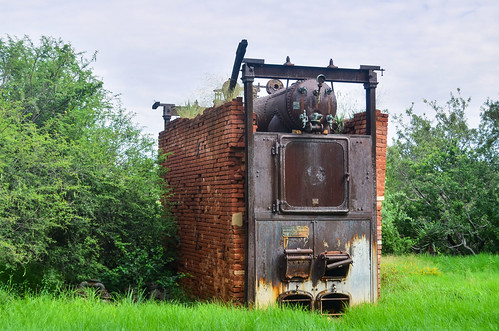
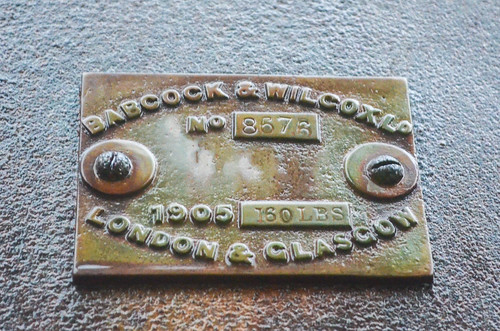
I wait a bit for my shoes to finish drying, I leave the locusts and I complete the last 20 kilometers to Tsumeb. Dave gave me a contact there.
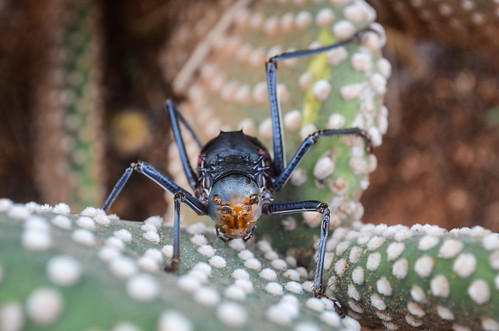
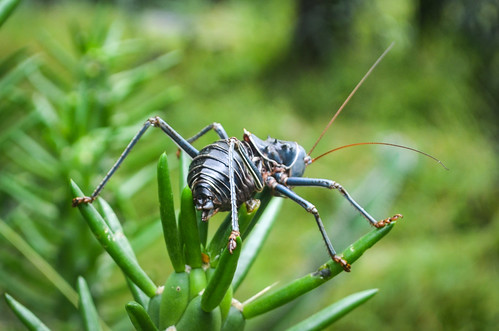
Tsumeb is a small mining town in the north of Namibia. It is well known for its rich mine, now closed, from which were extracted copper, lead, silver, gold, arsenic and germanium.

Unfortunately, my contact is not there at the moment. I roam around in search of cheap accommodation, but all the options are fully booked (and too expensive anyway). While eating a chicken burger (having a lot to catch up with, I never miss the opportunity to have a burger at a fast food), I contemplate the idea of leaving the town already and going camping. Giving Tsumeb a last try, I run into the Etosha Café, where there is wifi and affordable rooms. That’s all I need! At this time, I didn’t know I just entered the best place in town, and it is the start of a long break …
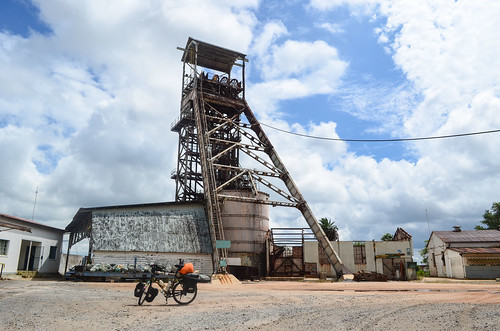
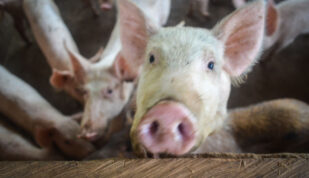
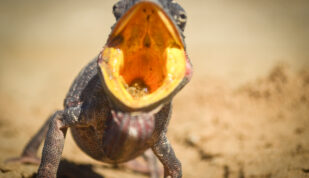
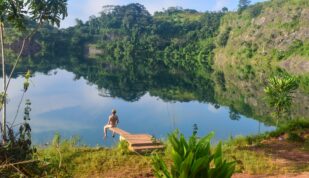
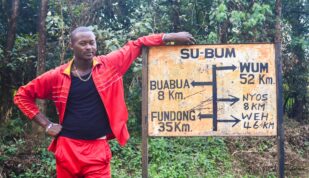

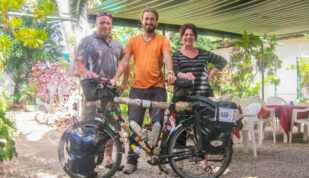

Up to 60% of the Namibian population, comprised of Aawambo (or Oshiwambo speaking people), is densely located in the socalled ‘Ovamboland’ in the central northern regions of Omusati, Oshana, Oshikoto and Ohangwena. From my point of view as an Environmental Consultant the main reason for this is the Cuvelai wetland also known as the ‘Oshana’ drainage system. As it is well known Namibia, like most of Southern Africa, is arid with very limited surface and groundwater resources. The only perennial rivers (Zambezi, Kavango, Kunene and Orange) are shared with other states. So for it is rare to find a single densely populated area without any a water resource support ecosystem. The Aawambo are said to have originated from East and central Africa; they migrated from there and settled in and around the Cuvelai wetland 200-400 years ago. Since then they continued to live there and protected their domain land from foreign invaders; first German settlers and later South African occupants.
The Cuvelai wetland provide Aawambo with ecosystem services such water for farming millet and livestock, fish and birds and wood. Millet production and livestock (mainly cattle) are pillars of the economy for Aawambo. For many years millet production and livestock sustained luxurious life of Kings to have as many as 10 wives and as many as 50 kids. Even ordinary wealthy man could own as many as 200 cattle without having conflicts over rangeland with other pastoralists.
It is apparent that in those good old days the Cuvelai wetland use to provide a favorable grazing lands compared to its present day state.
You were to lucky to have undertaken your trip between 2012 and 2014 when rain seasons were good in those particular years. At the moment the Cuvelai wetland is completely dry, having experienced extreme droughts in 2015 and 2016. These drought spells are expected to increase and last longer than usually due to impacts of climate change. Coping with these difficult climatic conditions, small holder farmers even remotely located areas of Ovamboland are slowly abandoning their traditional ways of farming. This include modernizing their ways of life. Unfortunately in the process, they are also losing their cultures.
This is perhaps the reason why development is so rapid in the area as evident from your narration:
“What really surprises me is the presence of many shops and food joints by the road. Despite the low population density, it’s easy to get a Russian & chips and a Coke every 10 or 20 km. There’s even small supermarkets in small settlements.”
Often as local people we rarely notice this as we have become pre-occupied with modern life that we perhaps relate less to our cultures. These are perhaps some of the difficulty realities we have to deal with when dealing with climate change and finding alternative economic pillars.
Really deep and accurate observation of trends experienced by Aawambo people over the years, Twali.
I loved JB’s review of north-central Namibia. As someone passionate about observing how people use and relate to spaces, I found so much richness in the description of his experiences and the entire narration of his Ovamboland experience through his photography.
It was such a creative fashion of storytelling, and JB, what sharp senses you have?! I definitely wish that many Namibians read your reviews, because there is so much significance in what you discuss, but as indigenous people, we are often caught up with life to notice all of these observations. I mean you have been in a better position to compare your experience in Namibia to the rest of African countries, so perhaps your reflections are what Namibians need to realize what we need to prioritize moving forward.
By the way, this was such a cool read. I enjoyed it! Felt like I was part of the journey. To more fun reads, Cheers!
Thanks Max!
I really loved Namibia, looking forward to return and see how populations have moved through time and places.
ps: My DSLR lens was just the entry level Nikon 🙂